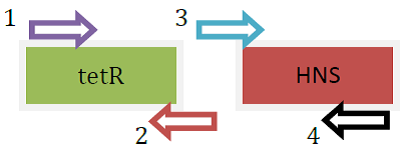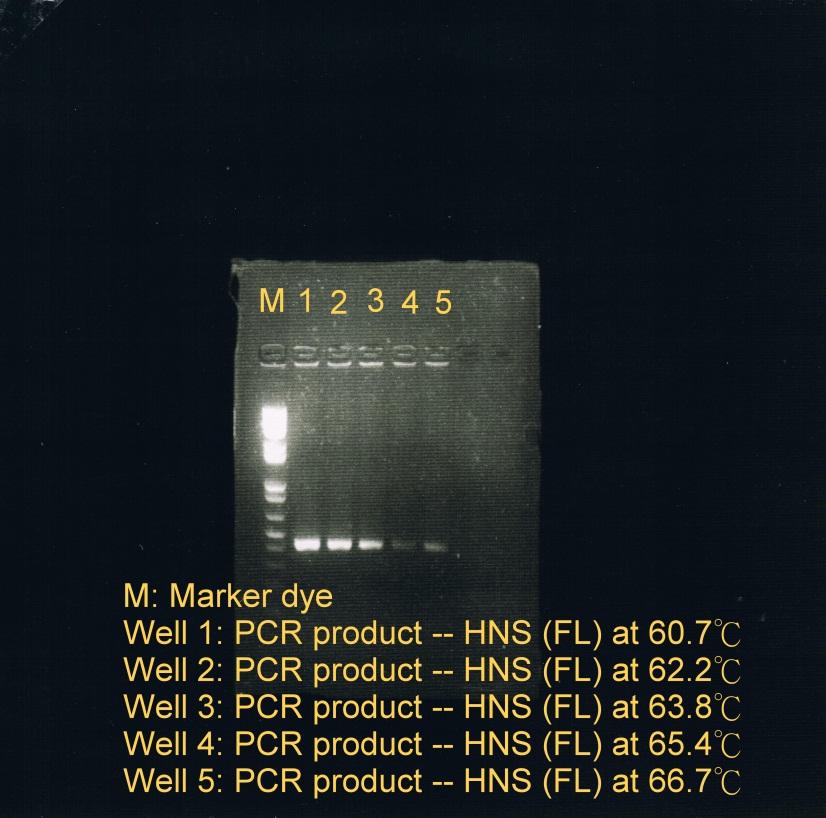Team:HKU-Hong Kong/Lab Diaries
From 2011.igem.org
(Difference between revisions)
| Line 12: | Line 12: | ||
<OL> | <OL> | ||
<LI>Reverse PCR was used to insert tetO2 -1 into pEGFP-loxp-km-loxp (template DNA) by using forward and reverse primers which are with the tetO2 -1. By using reverse PCR, we can insert the tetO2 -1 site into the pEGFP while the plasmid produced is still in double-stranded circular form. | <LI>Reverse PCR was used to insert tetO2 -1 into pEGFP-loxp-km-loxp (template DNA) by using forward and reverse primers which are with the tetO2 -1. By using reverse PCR, we can insert the tetO2 -1 site into the pEGFP while the plasmid produced is still in double-stranded circular form. | ||
| - | <LI>pEGFP-loxp-km-loxp-tetO2-1 was then transformed into DH10B to greatly amplify the product by using bacterial cells | + | <LI>pEGFP-loxp-km-loxp-tetO2-1 was then transformed into DH10B to greatly amplify the product by using bacterial cells. |
</OL> | </OL> | ||
<LI>tetO2 -2 (DNA biding site) | <LI>tetO2 -2 (DNA biding site) | ||
<OL> | <OL> | ||
| - | <LI>Reverse PCR was used to insert tetO2 -2 into pEGFP-loxp-km-loxp | + | <LI>Reverse PCR was used to insert tetO2 -2 into pEGFP-loxp-km-loxp. |
| - | <LI>2uL of 10-fold diluted pEGFP-loxp-km-loxp- tetO2 -2 was transformed into DH10B to greatly amplify the product by using bacterial cells | + | <LI>2uL of 10-fold diluted pEGFP-loxp-km-loxp- tetO2 -2 was transformed into DH10B to greatly amplify the product by using bacterial cells. |
</OL> | </OL> | ||
<LI>tetO2 – 3 (DNA binding site) | <LI>tetO2 – 3 (DNA binding site) | ||
<OL> | <OL> | ||
| - | <LI>Reverse PCR was used to insert tetO2 – 3 into pEGFP-loxp-km-loxp | + | <LI>Reverse PCR was used to insert tetO2 – 3 into pEGFP-loxp-km-loxp. |
| - | <LI>2uL of 10-fold diluted pEGFP-loxp-km-loxp- tetO2 – 3 was transformed into DH10B to greatly amplify the product by using bacterial cells | + | <LI>2uL of 10-fold diluted pEGFP-loxp-km-loxp- tetO2 – 3 was transformed into DH10B to greatly amplify the product by using bacterial cells. |
</OL> | </OL> | ||
|style="font-family: georgia, helvetica, arial, sans-serif;font-size:2em;color:#01DF01;"|Lab Diaries | |style="font-family: georgia, helvetica, arial, sans-serif;font-size:2em;color:#01DF01;"|Lab Diaries | ||
| Line 28: | Line 28: | ||
|style="width:900px;"|'''Week 3''' | |style="width:900px;"|'''Week 3''' | ||
<OL> | <OL> | ||
| - | <LI>Overlap PCR (involving 3 steps) was carried out to produce the fusion protein [tetR-HNS (any length)] | + | <LI>Overlap PCR (involving 3 steps) was carried out to produce the fusion protein [tetR-HNS (any length)]. |
<OL> | <OL> | ||
| - | <LI>PCR was carried out separately for 2 genes, tetR and HNS (full length, in this case) | + | <LI>PCR was carried out separately for 2 genes, tetR and HNS (full length, in this case). |
<OL> | <OL> | ||
<LI>Primers used were as below: | <LI>Primers used were as below: | ||
| Line 45: | Line 45: | ||
</OL> | </OL> | ||
<LI>Another PCR was carried out using primers with linker to insert the linker DNA to the tetR and HNS (FL) for the fusion of the 2 genes. | <LI>Another PCR was carried out using primers with linker to insert the linker DNA to the tetR and HNS (FL) for the fusion of the 2 genes. | ||
| - | <LI>PCR was used to further amplify the product from step 2 (fusion protein gene) | + | <LI>PCR was used to further amplify the product from step 2 (fusion protein gene). |
</OL> | </OL> | ||
| - | <LI>PCR was used to obtain HNS(FL) at 5 different temperatures to test which temperature is optimal for annealing | + | <LI>PCR was used to obtain HNS(FL) at 5 different temperatures to test which temperature is optimal for annealing. |
<OL> | <OL> | ||
<LI>Annealing phase at 5 different temperatures: (a) 60.7C; (b) 62.2C; (c) 63.8C; (d) 65.4C; (e) 66.7C (less sample) | <LI>Annealing phase at 5 different temperatures: (a) 60.7C; (b) 62.2C; (c) 63.8C; (d) 65.4C; (e) 66.7C (less sample) | ||
| Line 65: | Line 65: | ||
<LI>tetO2 – 0 and tetO2 – 4 | <LI>tetO2 – 0 and tetO2 – 4 | ||
<OL> | <OL> | ||
| - | <LI>Reverse PCR was used to insert tetO2 -0 and tetO2 – 4 into pEGFP-loxp-km-loxp | + | <LI>Reverse PCR was used to insert tetO2 -0 and tetO2 – 4 into pEGFP-loxp-km-loxp. |
| - | <LI>2uL of pEGFP-loxp-km-loxp- tetO2 – 0 and pEGFP-loxp-km-loxp- tetO2 – 4 were transformed into DH10B separately to greatly amplify the product by using bacterial cells | + | <LI>2uL of pEGFP-loxp-km-loxp- tetO2 – 0 and pEGFP-loxp-km-loxp- tetO2 – 4 were transformed into DH10B separately to greatly amplify the product by using bacterial cells. |
| + | |style="font-family: georgia, helvetica, arial, sans-serif;font-size:2em;color:#01DF01;"|Lab Diaries | ||
| + | |- | ||
| + | |style="width:900px;"|'''Week 6''' | ||
| + | <OL> | ||
| + | <LI>Overlap PCR was carried out to produce fusion protein gene | ||
| + | <OL> | ||
| + | <LI>HNS::tetR | ||
| + | <OL> | ||
| + | <LI>HNS (1-46); HNS (1-83); HNS (1-90); HNS (FL) | ||
| + | </OL> | ||
| + | <LI>tetR::HNS | ||
| + | <OL> | ||
| + | <LI>HNS (2-46); HNS (2-83); HNS (FL) | ||
| + | </OL> | ||
| + | </OL> | ||
Revision as of 17:24, 4 October 2011
| Lab Diaries | |
| Week 1
Transformation of reporter DNA (pEGFP-loxp-km-loxp) into DH10B (non-virulent strain E. coli) with antibiotic resistance (Chloramphenicol – Cm) | Lab Diaries |
Week 2
| Lab Diaries |
Week 3
| Lab Diaries |
Week 4-5
| Lab Diaries |
Week 6
|
 "
"




